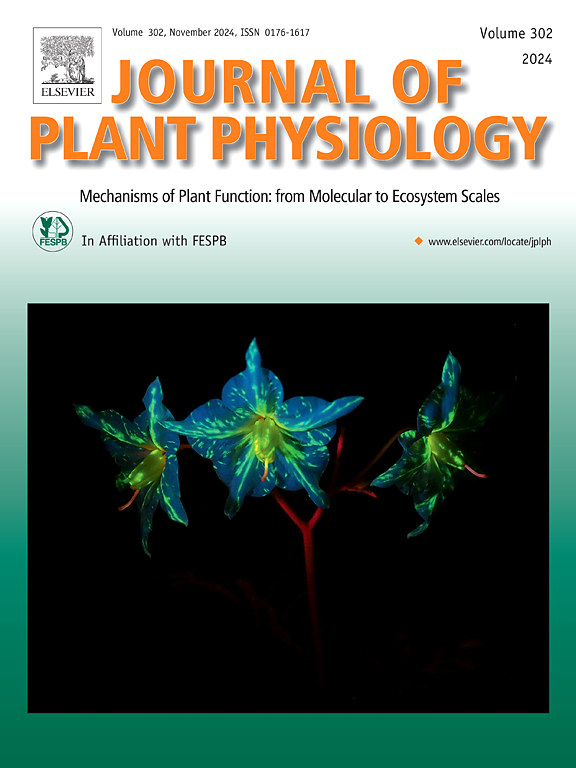英国橡树和黑杨根粘液的生化成分和微生物相互作用对比
IF 4.1
3区 生物学
Q1 PLANT SCIENCES
引用次数: 0
摘要
根粘液在植物与土壤的相互作用中起着至关重要的作用,但其组成和对树木的功能在很大程度上仍未被探索。本文研究了两种生长策略不同的树种:生长缓慢的栎树(Quercus robur L.)和生长迅速的黑杨树(Populus nigra L.)的根系粘液。我们的分析集中在粘液的多糖组成及其微生物的相互作用。英国橡树粘液多糖由54%的半乳糖、16%的甘露糖、11%的阿拉伯糖、7%的木糖和12%的葡萄糖醛酸组成,没有检测到葡萄糖或半乳糖醛酸。黑杨木胶多糖的半乳糖含量为26%,甘露糖含量为14%,葡萄糖含量为14%,阿拉伯糖含量为22%,木糖含量为7%,葡萄糖醛酸含量为14%,半乳糖醛酸含量为3%。这两种粘液类型都富含己糖,类似于土壤微生物源中常见的己糖与戊糖的比例。黑杨树胶浆的中性单糖比和K+、Na+浓度均高于栎木胶浆。在功能上,黑杨树粘液促进了荧光假单胞菌SBW25的生长,提示黑杨树粘液提供了可利用的碳源。相反,橡树粘液抑制细菌生长,可能是由于抗菌化合物可能减缓微生物分解和促进碳固存。本文章由计算机程序翻译,如有差异,请以英文原文为准。

Contrasting biochemical compositions and microbial interactions of English oak and black poplar root mucilage
Root mucilage plays a crucial role in plant-soil interactions, yet its composition and functions for trees remain largely unexplored. We investigated the root mucilage of two tree species with contrasting growth strategies: the slow-growing English oak (Quercus robur L.) and the fast-growing black poplar (Populus nigra L.). Our analyses focused on the polysaccharide composition of mucilage and its microbial interactions. English oak mucilage polysaccharides consisted of 54% galactose, 16% mannose, 11% arabinose, 7% xylose, and 12% glucuronic acid, with no detectable glucose or galacturonic acid. In contrast, black poplar mucilage polysaccharides contained 26% galactose, 14% mannose, 14% glucose, 22% arabinose, 7% xylose, 14% glucuronic acid, and 3% galacturonic acid. Both mucilage types were hexose-rich, resembling the hexose-to-pentose ratio common in microbial sources in soil. Black poplar mucilage had a higher uronic acid-to-neutral monosaccharide ratio and greater K+ and Na+ concentrations than English oak mucilage. Functionally, black poplar mucilage increased the growth of Pseudomonas fluorescens SBW25, suggesting the provision of readily available carbon sources. Conversely, English oak mucilage suppressed bacterial growth, plausibly due to antimicrobial compounds that may slow microbial decomposition and promote carbon sequestration.
求助全文
通过发布文献求助,成功后即可免费获取论文全文。
去求助
来源期刊

Journal of plant physiology
生物-植物科学
CiteScore
7.20
自引率
4.70%
发文量
196
审稿时长
32 days
期刊介绍:
The Journal of Plant Physiology is a broad-spectrum journal that welcomes high-quality submissions in all major areas of plant physiology, including plant biochemistry, functional biotechnology, computational and synthetic plant biology, growth and development, photosynthesis and respiration, transport and translocation, plant-microbe interactions, biotic and abiotic stress. Studies are welcome at all levels of integration ranging from molecules and cells to organisms and their environments and are expected to use state-of-the-art methodologies. Pure gene expression studies are not within the focus of our journal. To be considered for publication, papers must significantly contribute to the mechanistic understanding of physiological processes, and not be merely descriptive, or confirmatory of previous results. We encourage the submission of papers that explore the physiology of non-model as well as accepted model species and those that bridge basic and applied research. For instance, studies on agricultural plants that show new physiological mechanisms to improve agricultural efficiency are welcome. Studies performed under uncontrolled situations (e.g. field conditions) not providing mechanistic insight will not be considered for publication.
The Journal of Plant Physiology publishes several types of articles: Original Research Articles, Reviews, Perspectives Articles, and Short Communications. Reviews and Perspectives will be solicited by the Editors; unsolicited reviews are also welcome but only from authors with a strong track record in the field of the review. Original research papers comprise the majority of published contributions.
 求助内容:
求助内容: 应助结果提醒方式:
应助结果提醒方式:


